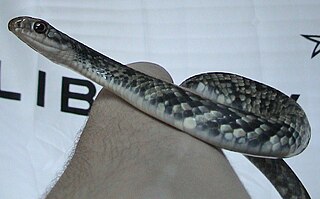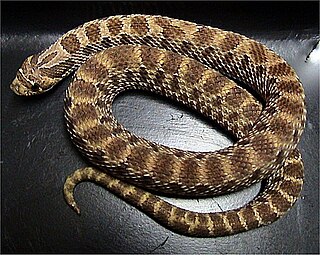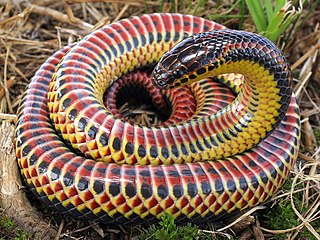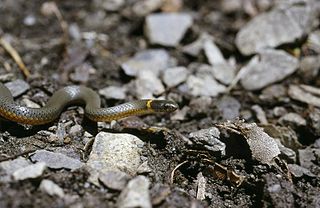
The smooth green snake is a species of North American nonvenomous snake in the family Colubridae. The species is also referred to as the grass snake. It is a slender, "small medium" snake that measures 36–51 cm (14–20 in) as an adult. It gets its common name from its smooth dorsal scales, as opposed to the rough green snake, which has keeled dorsal scales. The smooth green snake is found in marshes, meadows, open woods, and along stream edges, and is native to regions of Canada, the United States, and northern Mexico. A non-aggressive snake, it seldom bites and usually flees when threatened. It mates in late spring to summer, and females lay their eggs from June to September. The smooth green snake will often bob its head in order to mimic vegetation blowing in the wind.

Tropidoclonion is a genus of snake in the subfamily Natricinae of the family Colubridae. The genus is monotypic, containing the sole species Tropidoclonion lineatum, commonly known as the lined snake. The species is endemic to North America.

Diadophis punctatus, commonly known as the ring-necked snake or ringneck snake, is a rather small, harmless species of colubrid snake found throughout much of the United States, as well as south in Central Mexico and as far north as Quebec, Canada. Ring-necked snakes are generally fossorial and somewhat secretive, by nature, and, as a nocturnal species, are rarely seen during the daytime. These snakes are believed to be fairly abundant throughout most of their range, though no scientific evaluation supports this hypothesis. Scientific research is lacking for the species, despite their apparently common status, and more in-depth investigations are greatly needed. It is the only species within the genus Diadophis and, currently, 14 subspecies are identified, though many herpetologists question the morphologically-based classifications.

Cemophora coccinea, commonly known as the scarlet snake, is a species of nonvenomous snake in the family Colubridae. The species is native to the southeastern United States. There are two subspecies of C. coccinea that are recognized as being valid. The Texas scarlet snake was previously considered a subspecies.

The eastern racer, or North American racer, is a species of nonvenomous snake in the family Colubridae. The species is endemic to North America and Central America. Eleven subspecies, including the nominotypical subspecies, are recognized, which as a group are commonly referred to as the eastern racers. The species is monotypic in the genus Coluber.

The western hognose snake is a species of snake in the family Colubridae. The species is endemic to North America. There are three subspecies that are recognized as being valid, including the nominotypical subspecies.

Diadophis punctatus regalis, commonly known as the regal ringneck snake, is a subspecies of ringneck snake endemic to the southwestern United States and northern Mexico.

Sistrurus tergeminus edwardsii, also known as the desert massasauga, is a subspecies of venomous pit viper in the family Viperidae. The subspecies is endemic to the Southwestern United States and northern Mexico. In places, its range overlaps that of S. t. tergeminus, and intergrading of the two subspecies is known.

The smooth earth snake is a species of nonvenomous natricine colubrid snake native to the eastern half of the United States.

Virginia striatula, commonly called the rough earth snake, is a species of nonvenomous natricine colubrid snake native to the Southeastern United States.

Pituophis melanoleucus, commonly known as the eastern pine snake, is a species of nonvenomous snake in the family Colubridae. The species is endemic to the eastern United States. Three subspecies are currently recognized as being valid.

The crayfish snake, also known commonly as the glossy crayfish snake, the glossy swampsnake, the glossy water snake, and the striped water snake, is a species of semiaquatic snake in the subfamily Natricinae of the family Colubridae. The species is endemic to the southeastern United States, and preys mainly on crayfish.

Farancia erytrogramma is a species of large, nonvenomous, highly amphibious colubrid snake, endemic to the coastal plains of the southeastern United States. Two subspecies are recognized as being valid, one of which has been declared extinct.

Lampropeltis getula, commonly known as the eastern kingsnake, common kingsnake, or chain kingsnake, is a harmless colubrid species endemic to the United States. It has long been a favorite among collectors. Four subspecies are currently recognized, including the nominate subspecies described here. All of these taxa had originally been described as distinct species and recognized as such for up to 101 years.

The northern redbelly snake is a nonvenomous snake in the family Colubridae, a subspecies of Storeria occipitomaculata. It is native to North America.

Diadophis punctatus arnyi, also known commonly as the prairie ringneck snake, is a subspecies of small, thin snake in the family Dipsadidae. The subspecies is native to the Midwestern United States.

The midwestern worm snake, Carphophis amoenus helenae, a subspecies of C. amoenus, is a nonvenomous snake in the family Colubridae. The subspecies is endemic to the Midwest and Southern United States.

Diadophis punctatus stictogenys, commonly known as the Mississippi ringneck snake, is a subspecies of Diadophis punctatus that is endemic to the United States.

Lampropeltis triangulum triangulum, commonly known as the eastern milk snake or eastern milksnake, is a subspecies of the milk snake. The nonvenomous, colubrid snake is indigenous to eastern and central North America.



















